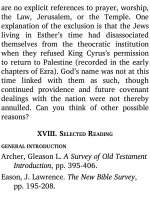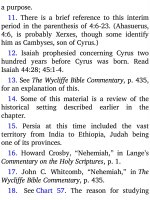Jensens survey of the old testament adam 100
Bạn đang xem bản rút gọn của tài liệu. Xem và tải ngay bản đầy đủ của tài liệu tại đây (118.01 KB, 4 trang )
already made in the Bible text.
6. Thus far you have concentrated on
observing the facts of the narrative. This is
the basis for moving on to interpretation and
application. In the remainder of your study
you will want to see especially the Messianic
character of the book.
IV. MAIN PURPOSES
Four of the book’s main purposes are cited
below.
1. Genealogy. The book introduces a few of
the ancestors of David, the royal lineage of
Christ the Messiah. Prominent is the
inclusion
of
a
non-Israelite
person
(Moabitess Ruth) in this line.
2. Typology. The kinsman-redeemer (Boaz)
is the prominent Messianic type. Ruth, then,
is the type of the Church, the Bride of
Christ. Some Bible students view Naomi as a
prominent type of Israel.5 Other types may
be seen in the book.
3. Theology. Underlying the entire book is
its revelation of the character and ways of
God: His providence, sovereignty, grace,
holiness, and His invitation of salvation to
all peoples.
4. History. As noted earlier, the book
describes a few intimate experiences of a
godly family of Bethlehem during the period
of the judges.
V. PROMINENT SUBJECTS
A. MAIN CHARACTERS
The main characters of the story are:
Naomi (“pleasant one”6)—a Jewess of
Bethlehem, wife of Elimelech, and
mother of two sons, Mahlon and Chilion.
Orpah (“neck”)—wife and widow of Chilion.
Ruth (“friendship”)—widow of Mahlon, who
later married Boaz.
Boaz (“in him is strength”)—a wealthy
Bethlehemite, distant relative of Mahlon,
who married Ruth.
B. KINSMAN-REDEEMER
Two key words of the story are “kinsman”
and “redeem,” which have given Boaz the
classic title, “kinsman-redeemer.”
Kinsman. This word (Heb., gô-ēl) appears
thirteen times in Ruth. It basically means
“one who redeems,” and in the setting of
Ruth refers to the near male relative of a
deceased man who had the right and duty to
buy back (i.e., redeem) land which had been
sold to another family, thus preventing the
alienation of the land and the extinction of
the family. If the nearest kinsman could not
ful ll such a redemption, the next of kin had
the opportunity. The sequence of the story is
described below:
1. When Naomi returned from Moab, she
sold her deceased husband’s property,
probably under pressure of poverty. A.
Macdonald writes: “Either Elimelech sold
the land before he went to Moab and the
year of jubilee came in the interval so that
the land reverted to Naomi—see Lev 25:8 .
—or the land was for the last ten years left
in the care of a friend.”7
2. It was necessary for a. go-ēl to redeem
the land in order to keep it in the family
name. By buying it back, however, “the gô-ēl
would not come into possession of the land
himself, but would hold it in trust for his
son by Ruth, who would inherit the name
and patrimony of Mahlon (her
rst
husband).”8. In this connection it should be
noted that it was Naomi who had prior
claim upon the gô-ēl but she surrendered it









